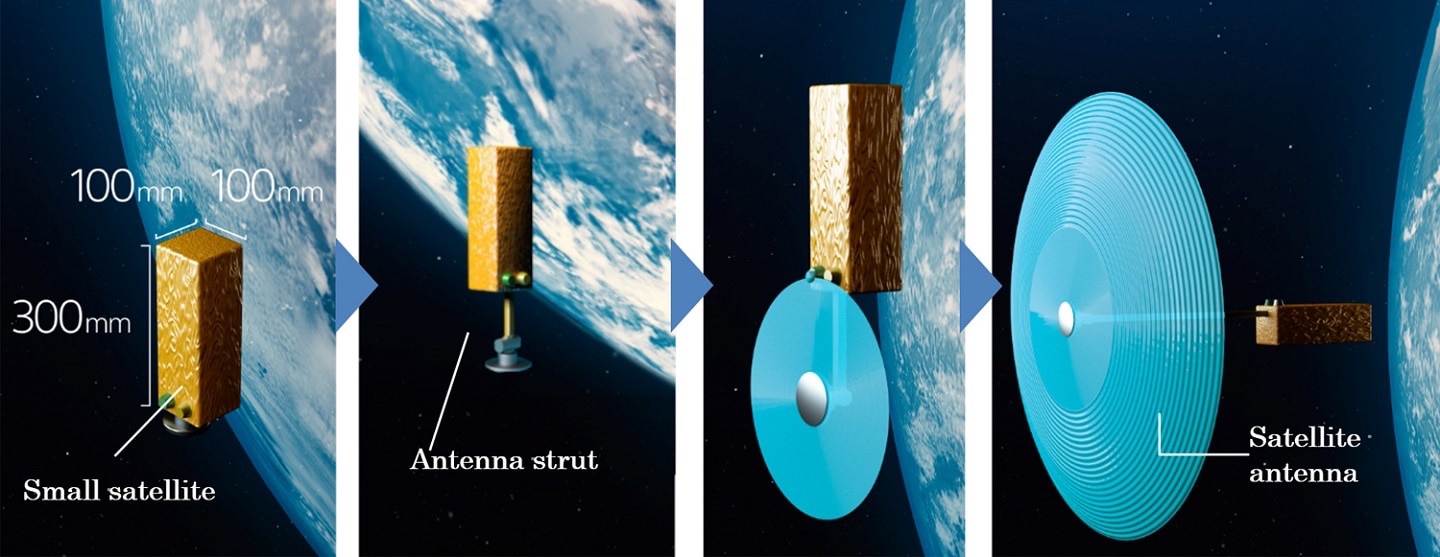
三菱:在外太空製造衛星天線
-在真空中實現3D層壓建模-
三菱電機:
在真空中具有適當的粘度,
由於紫外線具有固化穩定性,
開發UV固化樹脂。
在真空中實現了“不需要支撐材料的自由形式 3D 層壓建模”。
通過“使用陽光固化”,可以以低功耗製造結構。
發射後的天線打印:
我應用了這種技術。
如果你在發射後“打印”天線,
即使是只有幾十厘米的小衛星也能實現大開口的天線。
降低發射成本:
不再需要“考慮振動和衝擊的天線結構”和“用於展開天線的部件”。
通過“與支架和用於調整天線角度的電機共享”減輕了重量。
可以降低發射成本。
UV固化樹脂:
用於作為基礎材料的高分子量低聚物
加入真空油作為增塑劑,並適當混合固化抑製劑和固化引髮劑。
“低壓引起的樹脂蒸發”和
防止“因無氧而快速固化”,
實現“適合在真空中擠出/固化的穩定性”。
3U 立方體衛星(100 x 100 x 300 毫米):
這一次,假設用於 3U CubeSat 規格和小型人造衛星。
在大氣中製作直徑為 165mm 的天線反射器原型,並確認在 Ku 波段 (13.5GHz) 中的增益為 23.5dB。
400℃天線耐熱性:
天線原型為 0.2kPa 或更小
確認它具有400°C的耐熱性,足以在外太空使用。
(Impress Watch) –Yahoo! 新聞
https://news.yahoo.co.jp/articles/31c260b331b8dfbd6c51cd93f09fdac59ca89db6
Mitsubishi : fabrique des antennes satellites dans l’espace
-Réalisation de modélisation 3D laminée sous vide-
Mitsubishi électrique :
A la bonne viscosité dans le vide,
A une stabilité de durcissement due aux rayons ultraviolets,
Résine durcissable aux UV développée.
Une “modélisation laminée 3D de forme libre qui ne nécessite pas de matériaux de support” a été réalisée sous vide.En “utilisant la lumière du soleil pour le durcissement”, la structure peut être fabriquée avec une faible consommation d’énergie.
Impression d’antenne après le lancement :
J’ai appliqué cette technique.
Si vous “imprimez” l’antenne après le lancement,
Même un petit satellite qui ne fait que quelques dizaines de centimètres peut réaliser une antenne avec une grande ouverture.
Réduction du coût de lancement :
La “structure d’antenne tenant compte des vibrations et des chocs” et les “pièces pour déployer l’antenne” ne sont plus nécessaires.
Le poids a été réduit en “le partageant avec le support et le moteur de réglage de l’angle de l’antenne”.
Il est possible de réduire le coût de lancement.
Résine durcissable aux UV :
Pour les oligomères de haut poids moléculaire, qui sont le matériau de base
De l’huile sous vide a été ajoutée comme plastifiant, et l’inhibiteur de durcissement et l’initiateur de durcissement ont été mélangés de manière appropriée.
“Évaporation de la résine causée par la basse pression” et
Empêche le “durcissement rapide dû à l’absence d’oxygène”,
Atteint “une stabilité adaptée à l’extrusion/durcissement sous vide”.CubeSat 3U (100 x 100 x 300 mm) :
Cette fois, il est supposé être utilisé dans les spécifications 3U CubeSat et les petits satellites artificiels.
Réflecteur d’antenne prototype de 165 mm de diamètre dans l’atmosphère et confirmé un gain de 23,5 dB dans la bande Ku (13,5 GHz).
Résistance à la chaleur de l’antenne à 400 ℃ :
L’antenne prototypée à 0,2 kPa ou moins
Confirmé qu’il a une résistance à la chaleur de 400 ° C, ce qui est suffisant pour une utilisation dans l’espace.
(Impress Watch) — Yahoo ! Actualités
Mitsubishi: Stellt Satellitenantennen im Weltraum her
-Realisierung von laminierter 3D-Modellierung im Vakuum-
Mitsubishi Electric:
Hat die richtige Viskosität im Vakuum,
Härtungsstabilität durch ultraviolette Strahlen,
Entwickeltes UV-härtbares Harz.
„Laminierte 3D-Freiformmodellierung, die keine Stützmaterialien benötigt“ wurde im Vakuum realisiert.Durch „Verwenden von Sonnenlicht zum Aushärten“ kann die Struktur mit geringem Stromverbrauch hergestellt werden. Es war
Antennendruck nach dem Start:
Ich habe diese Technik angewendet.
Wenn Sie die Antenne nach dem Start “ausdrucken”,
Selbst ein kleiner Satellit, der nur wenige zehn Zentimeter groß ist, kann eine Antenne mit großer Öffnung realisieren.
Reduzierung der Startkosten:
„Antennenstruktur unter Berücksichtigung von Vibration und Schock“ und „Teile zum Ausfahren der Antenne“ entfallen.
Das Gewicht wurde reduziert, indem es “mit der Halterung und dem Motor zum Einstellen des Antennenwinkels geteilt” wurde.
Es ist möglich, die Startkosten zu reduzieren.
UV-härtbares Harz:
Für hochmolekulare Oligomere, die das Grundmaterial darstellen
Vakuumöl wurde als Weichmacher zugegeben und der Härtungsinhibitor und Härtungsinitiator wurden geeignet gemischt.
“Harzverdunstung durch Unterdruck” und
Verhindert „schnelles Aushärten durch Sauerstofffreiheit“,
Erreicht eine “für Extrusion / Aushärtung im Vakuum geeignete Stabilität”.3HE CubeSat (100 x 100 x 300 mm):
Diesmal wird davon ausgegangen, dass es in 3U-CubeSat-Spezifikationen und kleinen künstlichen Satelliten verwendet wird.
Prototyp eines Antennenreflektors mit 165 mm Durchmesser in der Atmosphäre und bestätigte eine Verstärkung von 23,5 dB im Ku-Band (13,5 GHz).
Hitzebeständigkeit der Antenne bei 400 ℃:
Der Antennenprototyp bei 0,2 kPa oder weniger
Bestätigt, dass es eine Hitzebeständigkeit von 400°C hat, was für den Einsatz im Weltraum ausreicht.
(Impress Watch) –Yahoo!-Nachrichten
Mitsubishi Electric Develops Technology for the Freeform Printing of Satellite Antennas in Outer Space
UNITED STATES TOKYO,
May 17, 2022 –Mitsubishi Electric Corporation (TOKYO: 6503) announced today
that the company has developed an on-orbit additive-manufacturing technology that uses photosensitive resin and solar ultraviolet light for the 3D printing of satellite antennas in the vacuum of outer space.
The novel technology
makes use of a newly developed liquid resin that was custom formulated for stability in vacuum.The resin enables structures
to be fabricated in space using a low-power process that utilizes the sun’s ultraviolet rays for photopolymerization.The technology specifically addresses
the challenge of equipping small, inexpensive spacecraft buses with large structures, such as high-gain antenna reflectors,
and enables on-orbit fabrication of structures that greatly exceed the dimensions of launch vehicle fairings.
Resin-based on-orbit manufacturing
is expected to enable spacecraft structures to be made thinner and lighter than conventional designs,
which must survive the stresses of launch and orbital insertion, thereby reducing both total satellite weight and launch costs.
Spacecraft antenna designs
are challenging due to their conflicting requirements for high gain, wide bandwidth, and low weight.High gain and wide bandwidth necessarily require a large aperture,
but economical orbital deployment conventionally dictates that designs be lightweight and small enough to fit or fold inside a launch vehicle or satellite deployment mechanism.
Mitsubishi Electric’s innovative approach—resin-based on-orbit manufacturing—
efficiently realizes high-gain, wide-bandwidth, large-aperture antennas deployed from a lightweight, vibration-resistant launch package.
By developing a 3D printer
that extrudes a custom ultraviolet-curable resin formulated for vacuum, resin-based low-power freeform*additive-manufacturing in space has now become possible.
2022 | Global News | MITSUBISHI ELECTRIC
https://us.mitsubishielectric.com/en/news/releases/global/2022/0517-a/index.html